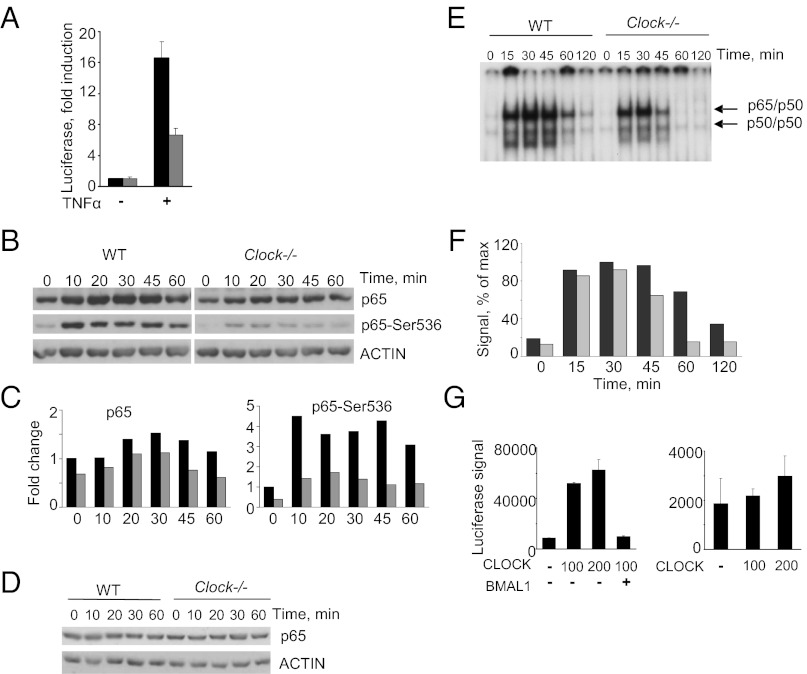Fig. 4.
NF-κB activation is reduced in Clock-deficient MEFs. (A) WT (black bars) and Clock-deficient (gray bars) MEFs stably expressing κB-Luc reporter were treated with 2 ng/mL TNF-α for 5 h, and luciferase activity was measured in cell lysates. (B) Clock-deficient cells show reduced levels of nuclear phospho-active p65 after TNF-α–mediated NF-κB activation. WT and Clock-deficient MEF cells were treated with 2 ng/mL of TNF-α for the indicated times and were used to prepare nuclear extracts, which were analyzed by Western blots with antibodies against total p65 and its pSer536 phosphorylated form. (C) Quantitative analysis of the Western blot shown in B. ACTIN was used as a loading control. Black bars, WT; gray bars, Clock-deficient MEFs. (D) Deficiency in Clock has no effect on total levels of p65. WT and Clock-deficient MEFs were treated with 2 ng/mL of TNF-α for the indicated times. Total cell lysates were analyzed by Western blot as in B. (E) Impaired induction of NF-κB DNA binding in Clock−/− MEF cells treated with TNF-α. WT and Clock-deficient MEFs were treated with 1 ng/mL TNF-α for the indicated times. (F) Quantitative analysis of intensity of the band corresponding to DNA-bound p65/p50 dimer. The amount of DNA-bound complex in Clock-deficient MEFs (gray bars) is reduced compared with WT MEFs (black bars); the decrease is particularly pronounced after 45 min of TNF-α treatment, suggesting that the overall amount of active NF-κB is diminished in Clock-deficient MEFs. (G) CLOCK has no effect on the DNA-binding properties of p65. HEK-293T cells were cotransfected with a luciferase reporter gene encoding a GAL4-binding element and plasmid encoding a p65 fusion of the GAL4 DNA-binding domain. The CLOCK- and BMAL1-expressing plasmids were transfected as indicated to show CLOCK’s dose-dependent effect on p65 activation and BMAL1’s capacity to counter this effect (Left). The GAL4 luciferase reporter gene also was transfected with the CLOCK-expressing plasmid to show that CLOCK did not drive expression of the reporter gene (Right).

